stop start DODGE DURANGO 2005 2.G Owner's Manual
[x] Cancel search | Manufacturer: DODGE, Model Year: 2005, Model line: DURANGO, Model: DODGE DURANGO 2005 2.GPages: 416, PDF Size: 14.25 MB
Page 267 of 416
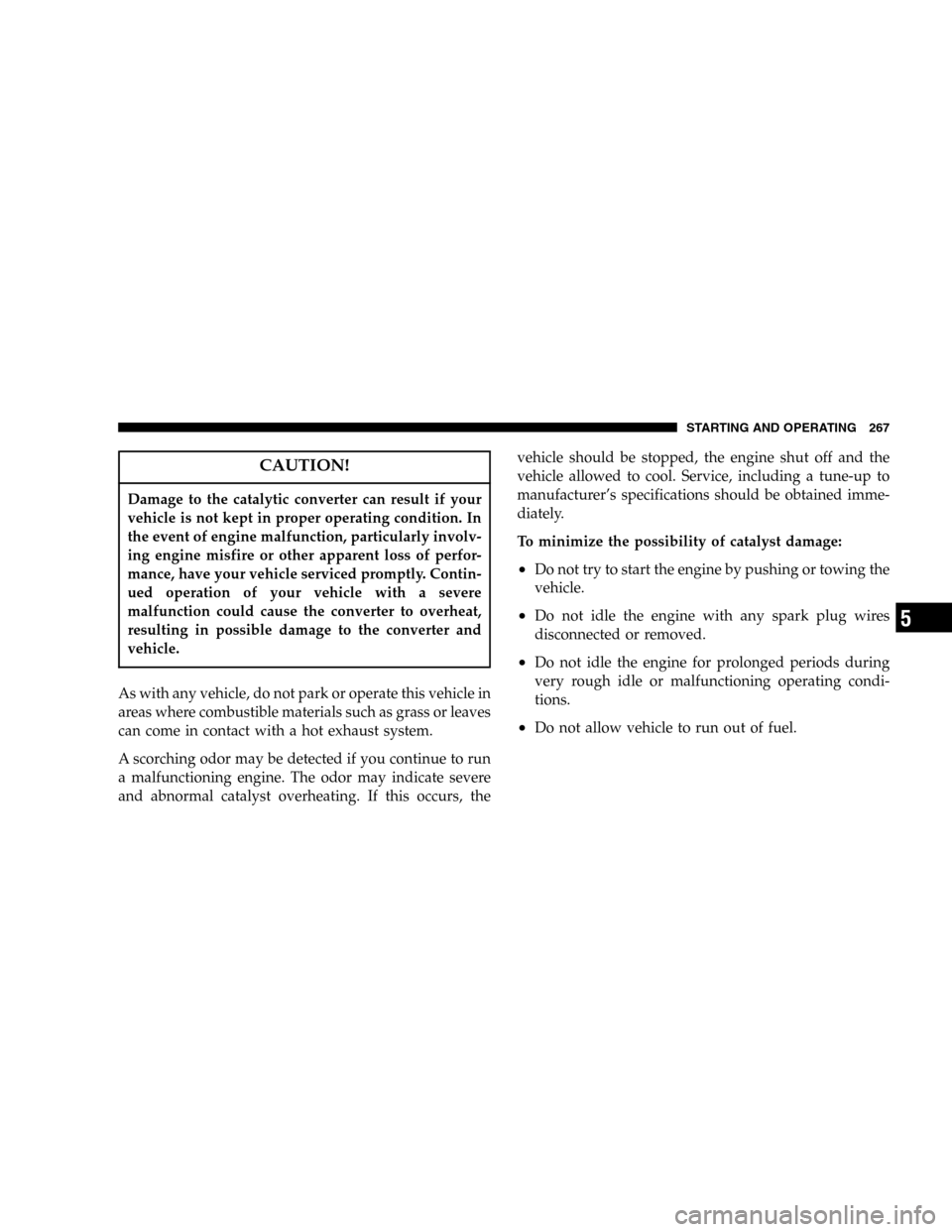
CAUTION!
Damage to the catalytic converter can result if your
vehicle is not kept in proper operating condition. In
the event of engine malfunction, particularly involv-
ing engine misfire or other apparent loss of perfor-
mance, have your vehicle serviced promptly. Contin-
ued operation of your vehicle with a severe
malfunction could cause the converter to overheat,
resulting in possible damage to the converter and
vehicle.
As with any vehicle, do not park or operate this vehicle in
areas where combustible materials such as grass or leaves
can come in contact with a hot exhaust system.
A scorching odor may be detected if you continue to run
a malfunctioning engine. The odor may indicate severe
and abnormal catalyst overheating. If this occurs, thevehicle should be stopped, the engine shut off and the
vehicle allowed to cool. Service, including a tune-up to
manufacturer’s specifications should be obtained imme-
diately.
To minimize the possibility of catalyst damage:
•Do not try to start the engine by pushing or towing the
vehicle.
•Do not idle the engine with any spark plug wires
disconnected or removed.
•Do not idle the engine for prolonged periods during
very rough idle or malfunctioning operating condi-
tions.
•Do not allow vehicle to run out of fuel.
STARTING AND OPERATING 267
5
Page 276 of 416
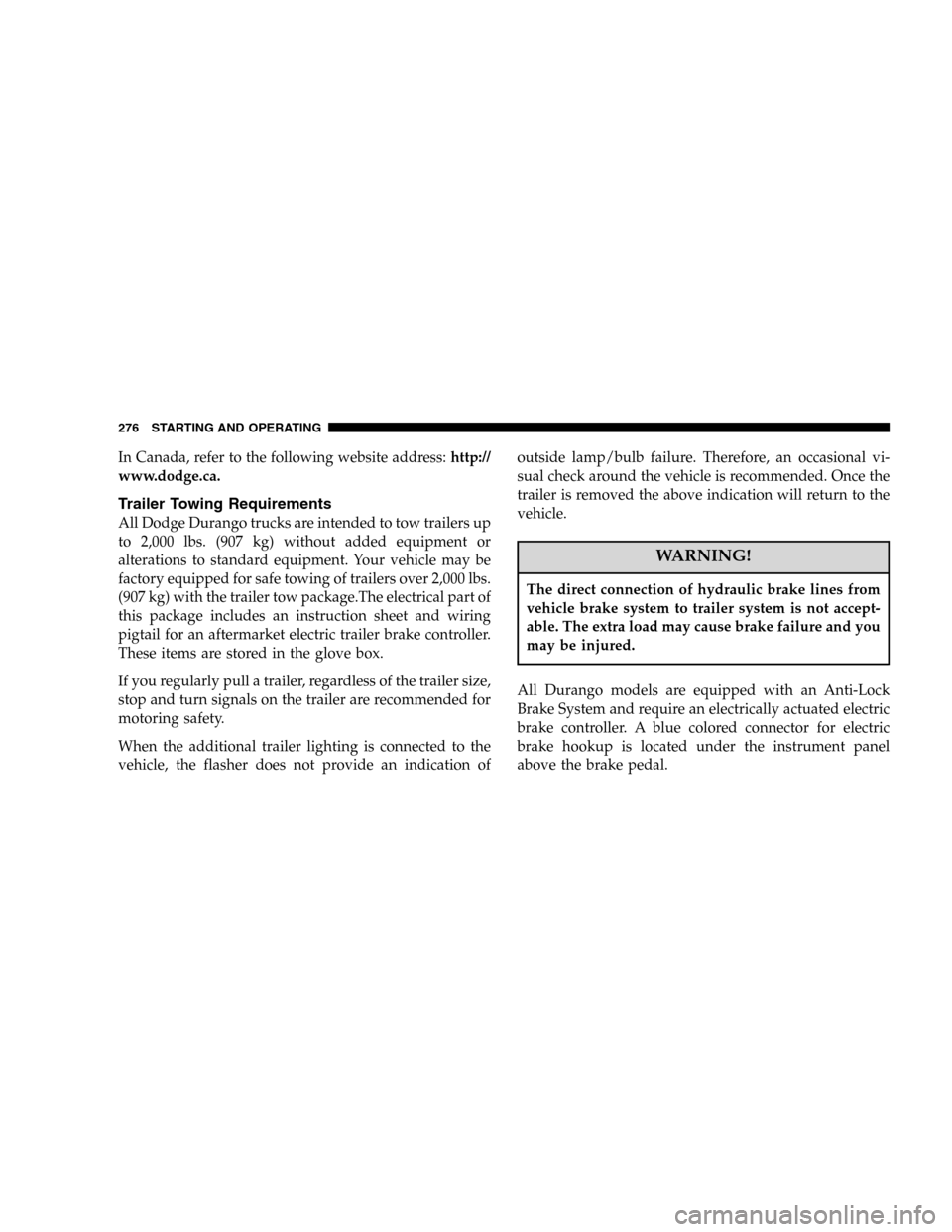
In Canada, refer to the following website address:http://
www.dodge.ca.
Trailer Towing Requirements
All Dodge Durango trucks are intended to tow trailers up
to 2,000 lbs. (907 kg) without added equipment or
alterations to standard equipment. Your vehicle may be
factory equipped for safe towing of trailers over 2,000 lbs.
(907 kg) with the trailer tow package.The electrical part of
this package includes an instruction sheet and wiring
pigtail for an aftermarket electric trailer brake controller.
These items are stored in the glove box.
If you regularly pull a trailer, regardless of the trailer size,
stop and turn signals on the trailer are recommended for
motoring safety.
When the additional trailer lighting is connected to the
vehicle, the flasher does not provide an indication ofoutside lamp/bulb failure. Therefore, an occasional vi-
sual check around the vehicle is recommended. Once the
trailer is removed the above indication will return to the
vehicle.
WARNING!
The direct connection of hydraulic brake lines from
vehicle brake system to trailer system is not accept-
able. The extra load may cause brake failure and you
may be injured.
All Durango models are equipped with an Anti-Lock
Brake System and require an electrically actuated electric
brake controller. A blue colored connector for electric
brake hookup is located under the instrument panel
above the brake pedal.
276 STARTING AND OPERATING
Page 278 of 416
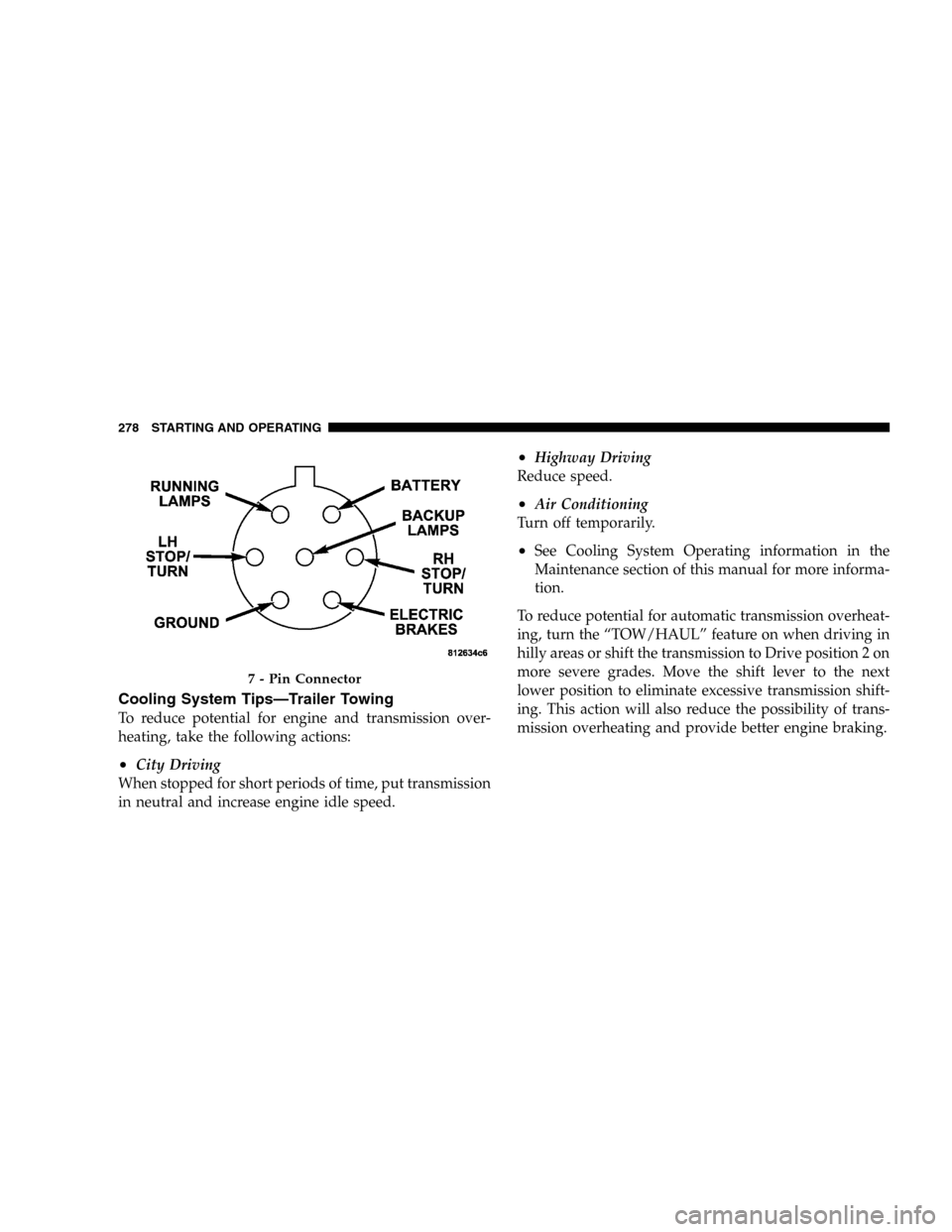
Cooling System Tips—Trailer Towing
To reduce potential for engine and transmission over-
heating, take the following actions:
•City Driving
When stopped for short periods of time, put transmission
in neutral and increase engine idle speed.
•Highway Driving
Reduce speed.
•Air Conditioning
Turn off temporarily.
•See Cooling System Operating information in the
Maintenance section of this manual for more informa-
tion.
To reduce potential for automatic transmission overheat-
ing, turn the “TOW/HAUL” feature on when driving in
hilly areas or shift the transmission to Drive position 2 on
more severe grades. Move the shift lever to the next
lower position to eliminate excessive transmission shift-
ing. This action will also reduce the possibility of trans-
mission overheating and provide better engine braking.
7 - Pin Connector
278 STARTING AND OPERATING
Page 281 of 416
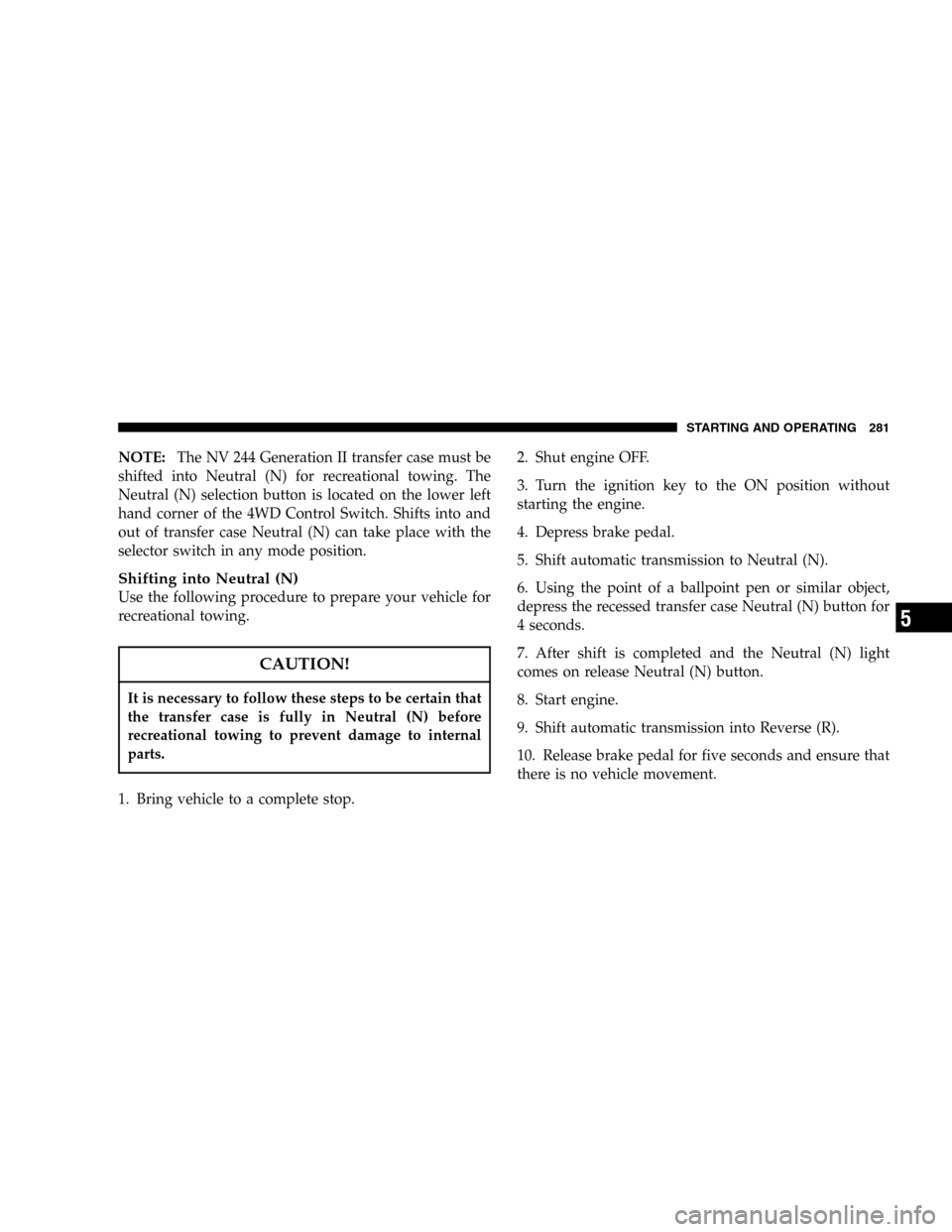
NOTE:The NV 244 Generation II transfer case must be
shifted into Neutral (N) for recreational towing. The
Neutral (N) selection button is located on the lower left
hand corner of the 4WD Control Switch. Shifts into and
out of transfer case Neutral (N) can take place with the
selector switch in any mode position.
Shifting into Neutral (N)
Use the following procedure to prepare your vehicle for
recreational towing.
CAUTION!
It is necessary to follow these steps to be certain that
the transfer case is fully in Neutral (N) before
recreational towing to prevent damage to internal
parts.
1. Bring vehicle to a complete stop.2. Shut engine OFF.
3. Turn the ignition key to the ON position without
starting the engine.
4. Depress brake pedal.
5. Shift automatic transmission to Neutral (N).
6. Using the point of a ballpoint pen or similar object,
depress the recessed transfer case Neutral (N) button for
4 seconds.
7. After shift is completed and the Neutral (N) light
comes on release Neutral (N) button.
8. Start engine.
9. Shift automatic transmission into Reverse (R).
10. Release brake pedal for five seconds and ensure that
there is no vehicle movement.
STARTING AND OPERATING 281
5
Page 282 of 416
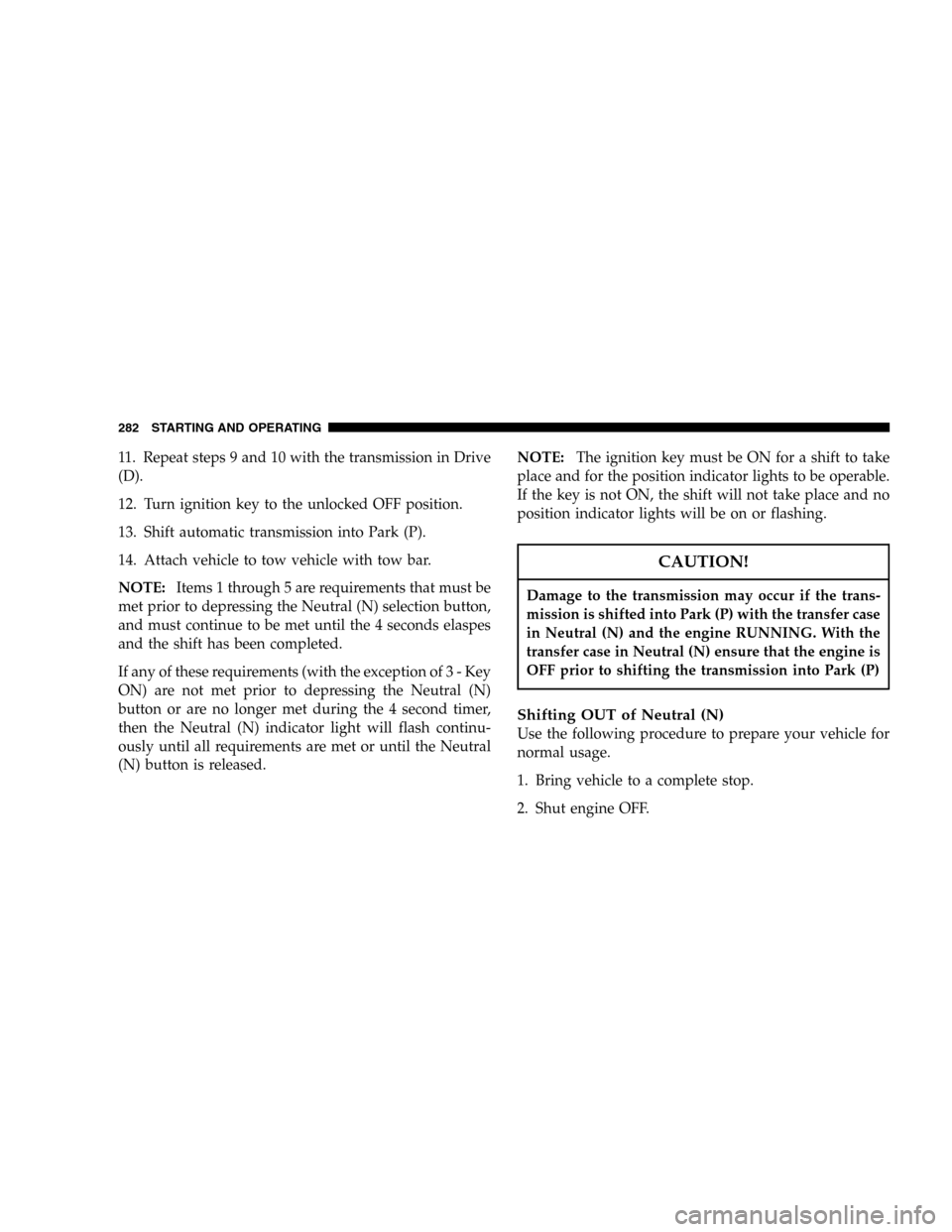
11. Repeat steps 9 and 10 with the transmission in Drive
(D).
12. Turn ignition key to the unlocked OFF position.
13. Shift automatic transmission into Park (P).
14. Attach vehicle to tow vehicle with tow bar.
NOTE:Items 1 through 5 are requirements that must be
met prior to depressing the Neutral (N) selection button,
and must continue to be met until the 4 seconds elaspes
and the shift has been completed.
If any of these requirements (with the exception of3-Key
ON) are not met prior to depressing the Neutral (N)
button or are no longer met during the 4 second timer,
then the Neutral (N) indicator light will flash continu-
ously until all requirements are met or until the Neutral
(N) button is released.NOTE:The ignition key must be ON for a shift to take
place and for the position indicator lights to be operable.
If the key is not ON, the shift will not take place and no
position indicator lights will be on or flashing.
CAUTION!
Damage to the transmission may occur if the trans-
mission is shifted into Park (P) with the transfer case
in Neutral (N) and the engine RUNNING. With the
transfer case in Neutral (N) ensure that the engine is
OFF prior to shifting the transmission into Park (P)
Shifting OUT of Neutral (N)
Use the following procedure to prepare your vehicle for
normal usage.
1. Bring vehicle to a complete stop.
2. Shut engine OFF.
282 STARTING AND OPERATING
Page 284 of 416
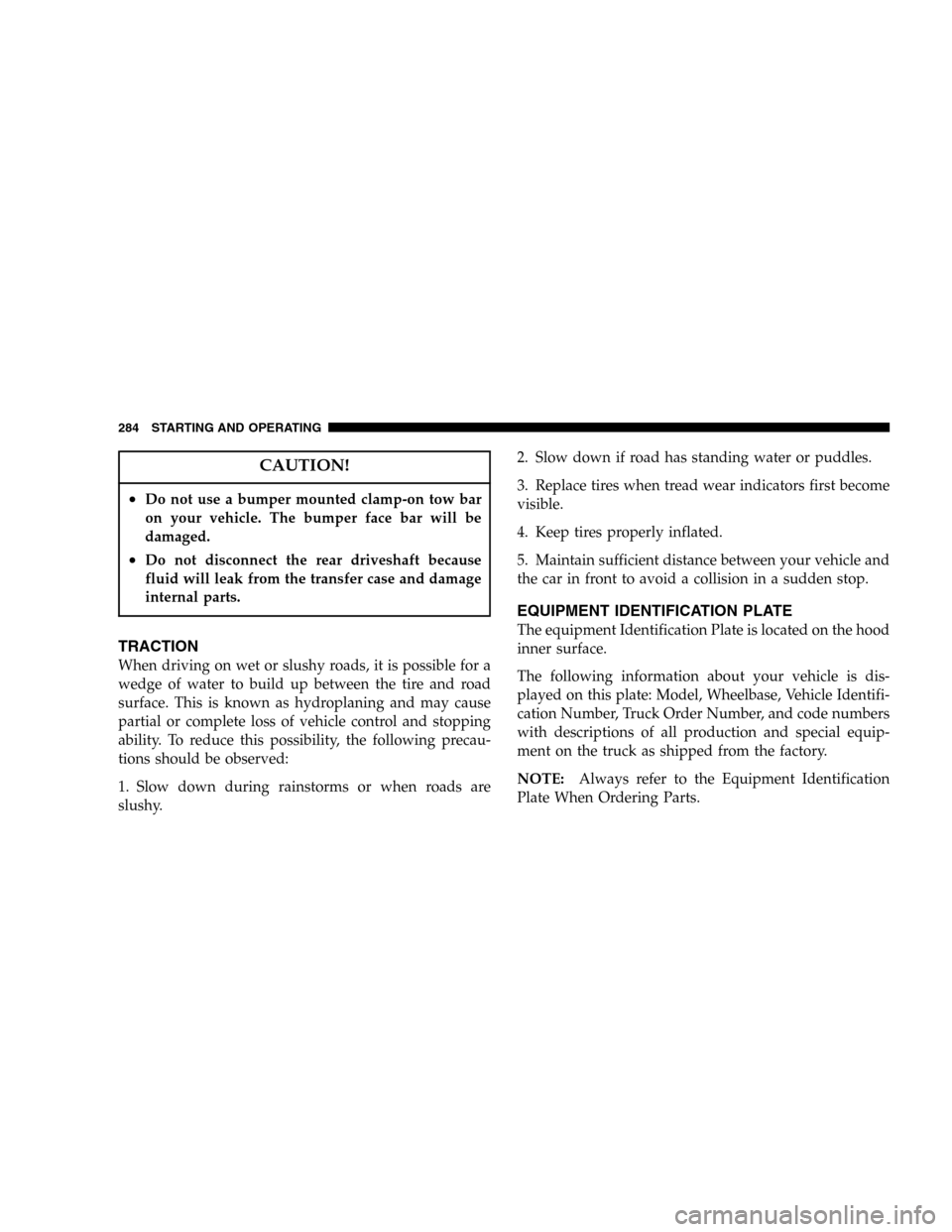
CAUTION!
•Do not use a bumper mounted clamp-on tow bar
on your vehicle. The bumper face bar will be
damaged.
•Do not disconnect the rear driveshaft because
fluid will leak from the transfer case and damage
internal parts.
TRACTION
When driving on wet or slushy roads, it is possible for a
wedge of water to build up between the tire and road
surface. This is known as hydroplaning and may cause
partial or complete loss of vehicle control and stopping
ability. To reduce this possibility, the following precau-
tions should be observed:
1. Slow down during rainstorms or when roads are
slushy.2. Slow down if road has standing water or puddles.
3. Replace tires when tread wear indicators first become
visible.
4. Keep tires properly inflated.
5. Maintain sufficient distance between your vehicle and
the car in front to avoid a collision in a sudden stop.
EQUIPMENT IDENTIFICATION PLATE
The equipment Identification Plate is located on the hood
inner surface.
The following information about your vehicle is dis-
played on this plate: Model, Wheelbase, Vehicle Identifi-
cation Number, Truck Order Number, and code numbers
with descriptions of all production and special equip-
ment on the truck as shipped from the factory.
NOTE:Always refer to the Equipment Identification
Plate When Ordering Parts.
284 STARTING AND OPERATING
Page 318 of 416
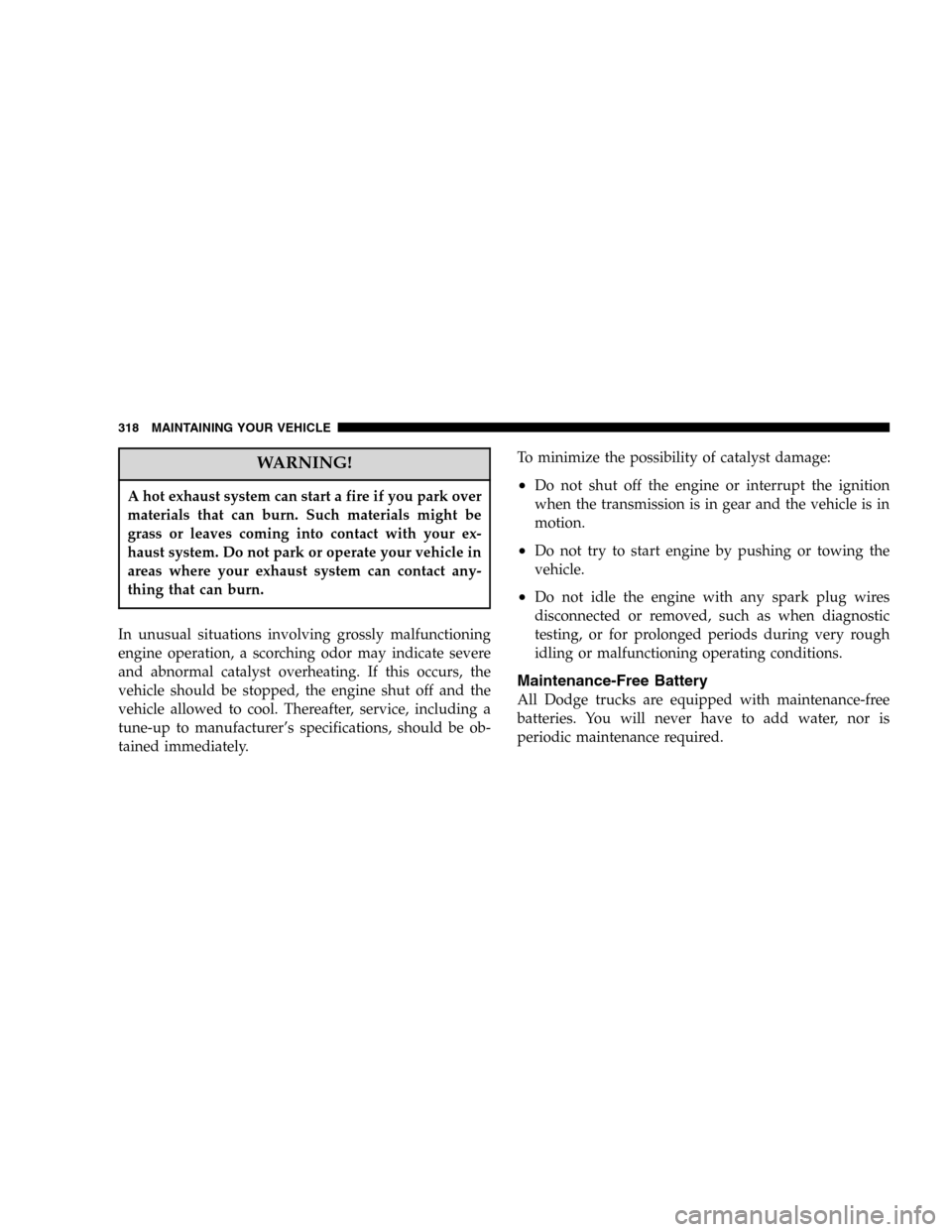
WARNING!
A hot exhaust system can start a fire if you park over
materials that can burn. Such materials might be
grass or leaves coming into contact with your ex-
haust system. Do not park or operate your vehicle in
areas where your exhaust system can contact any-
thing that can burn.
In unusual situations involving grossly malfunctioning
engine operation, a scorching odor may indicate severe
and abnormal catalyst overheating. If this occurs, the
vehicle should be stopped, the engine shut off and the
vehicle allowed to cool. Thereafter, service, including a
tune-up to manufacturer’s specifications, should be ob-
tained immediately.To minimize the possibility of catalyst damage:
•Do not shut off the engine or interrupt the ignition
when the transmission is in gear and the vehicle is in
motion.
•Do not try to start engine by pushing or towing the
vehicle.
•Do not idle the engine with any spark plug wires
disconnected or removed, such as when diagnostic
testing, or for prolonged periods during very rough
idling or malfunctioning operating conditions.
Maintenance-Free Battery
All Dodge trucks are equipped with maintenance-free
batteries. You will never have to add water, nor is
periodic maintenance required.
318 MAINTAINING YOUR VEHICLE
Page 346 of 416
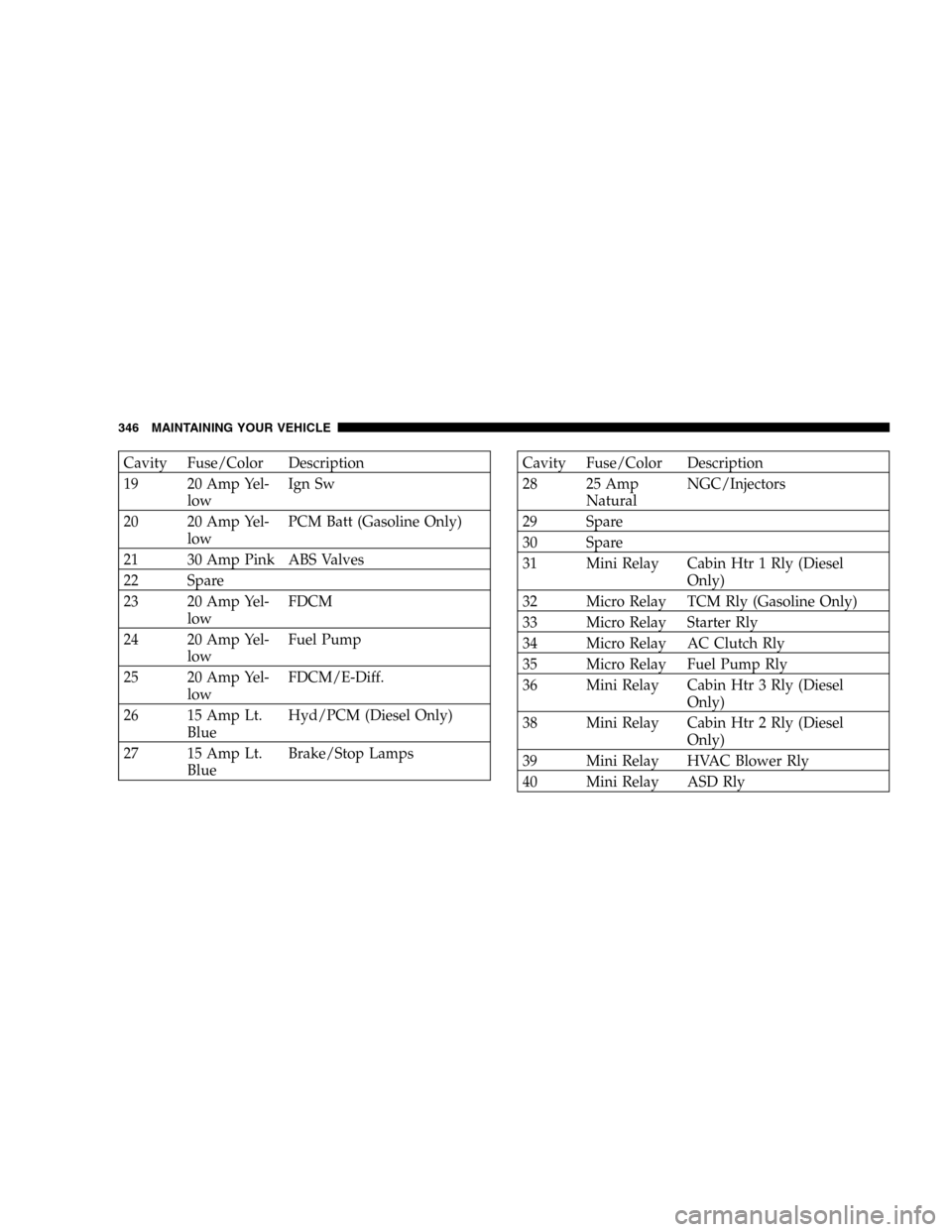
Cavity Fuse/Color Description
19 20 Amp Yel-
lowIgn Sw
20 20 Amp Yel-
lowPCM Batt (Gasoline Only)
21 30 Amp Pink ABS Valves
22 Spare
23 20 Amp Yel-
lowFDCM
24 20 Amp Yel-
lowFuel Pump
25 20 Amp Yel-
lowFDCM/E-Diff.
26 15 Amp Lt.
BlueHyd/PCM (Diesel Only)
27 15 Amp Lt.
BlueBrake/Stop LampsCavity Fuse/Color Description
28 25 Amp
NaturalNGC/Injectors
29 Spare
30 Spare
31 Mini Relay Cabin Htr 1 Rly (Diesel
Only)
32 Micro Relay TCM Rly (Gasoline Only)
33 Micro Relay Starter Rly
34 Micro Relay AC Clutch Rly
35 Micro Relay Fuel Pump Rly
36 Mini Relay Cabin Htr 3 Rly (Diesel
Only)
38 Mini Relay Cabin Htr 2 Rly (Diesel
Only)
39 Mini Relay HVAC Blower Rly
40 Mini Relay ASD Rly
346 MAINTAINING YOUR VEHICLE